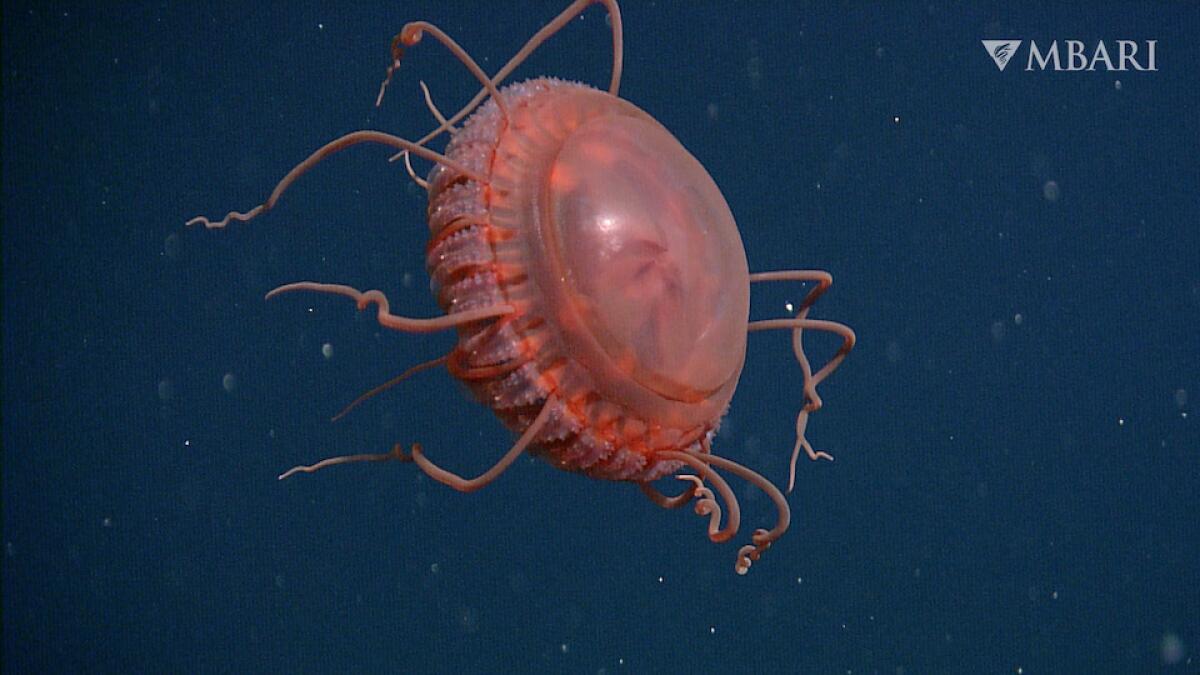Jelly? Researchers discover new deep-sea creature in Monterey Bay

- Share via
Researchers in Monterey Bay have discovered a new species of deep-sea jelly that looks a little different from others that float through the ocean’s depths.
Dubbed Atolla reynoldsi, the scarlet crown jelly was first found by Monterey Bay Aquarium Research Institute researchers 15 years ago as it swam more than 4,000 feet below the ocean’s surface. Now, they’ve published the scientific description of the relatively large new species of Atolla in the scientific journal Animals. Scientists prefer the term jelly or medusa over jellyfish because the creatures are not fish.
Among the telltale traits of Atolla reynoldsi? The lack of the trailing tentacle for which the Atolla jelly is known. The elongated tentacle can stretch up to six times the diameter of its bell — a feature researchers believe aids in capturing prey.
“When we started seeing this, it caught our attention,” said George Matsumoto, a senior education and research specialist at MBARI. “It also has these really interesting spikes on it, or papillae. It looks sort of like the spokes on a bicycle wheel.”
The tentacles are also coiled like springs, he said, which is unusual compared to the flowing tentacles Atolla jelly have. Matsumoto, first author on the description of this new species, said that it’s not clear why the tentacles are curled. In distantly related jellies, the creatures use them like springs that pop out when they contact prey.
“Everything brings up more questions,” he said with a laugh.
Tentacle numbers vary from one creature to the next, and A. reynoldsi can have anywhere from 26 to 39 tentacles.

The Atolla crown jelly lives in oceans around the globe and can be abundant in deep water, according to the research institute. The creatures live in the midnight zone, a part of the ocean so deep that it can’t be penetrated by sunlight.
The researchers named their discovery A. reynoldsi in honor of Jeff Reynolds, the first volunteer at the Monterey Bay Aquarium, the research institute’s education and conservation partner. Matsumoto, a volunteer diver at the aquarium, said he had the idea to name the species after a volunteer to honor the millions of hours volunteers have spent helping with ocean conservation efforts.
So far, researchers have found the new species only off Monterey Bay. But Matsumoto believes the jelly isn’t unique to the area.
The institute’s archive of more than 27,600 hours of video contains thousands of observations of Atolla. Scientists recognize 10 species in the genus, but Matsumoto and his co-authors think two more previously unknown species of Atolla live in the depths of Monterey Bay.
Researchers have not given the other two jellies names because they don’t have enough specimens to reach that stage in their research, Matsumoto said. The other two are about the same size and also lack the trailing tentacles. One of the undescribed species has similar bumps but lacks the bicycle spoke structure, he said. One also appears to be white rather than reddish, but researchers have seen only three of them so far.
Scientists can’t yet tell whether the distinctive color is because those particular jellies “are not doing well or if they don’t have the scarlet color,” he said.
The latest paper, Matsumoto said, serves as a plea to his peers around the world to “keep an eye out for these other two and collect if you see them.”
“The ocean is full of species that are yet to be described by science,” he said.
Crown jellies have often been collected in nets, viewed by people in submersibles or remotely through video, he added. But researchers “haven’t really worked on them very much.”
“One of our hopes is that this makes people take a step back. Even for these animals we think are common, we don’t know much,” Matsumoto said. “We need to find out what they eat. Who eats them? What is their place in the ecosystem?”
Mining firms want to scrape the seabed for minerals used in electric car batteries. Scientists worry about conflicts of interest with the gatekeeper to mining permits.
A. reynoldsi is larger than other species of Atolla. The biggest specimen researchers collected was 5.1 inches in diameter, one of the largest in the genus.
Like other deep-sea crown jellies, the new species has a furrowed bell with a deep groove separating the dome from the wide margin with thick segments, known as pedalia. The edge of the bell resembles a coronet, the inspiration for its regal name.
A. reynoldsi also has a distinct stomach that is shaped like a Greek cross, whereas most other crown jellies have a clover-shaped gut. The new species is also a little more elongated, Matsumoto said.
“The ocean is the world’s largest habitat,” he said. “We need to know more about it.”
More to Read
Sign up for Essential California
The most important California stories and recommendations in your inbox every morning.
You may occasionally receive promotional content from the Los Angeles Times.











